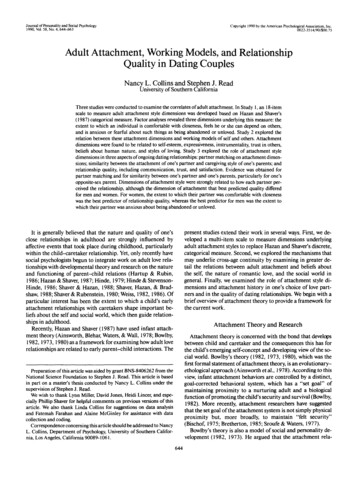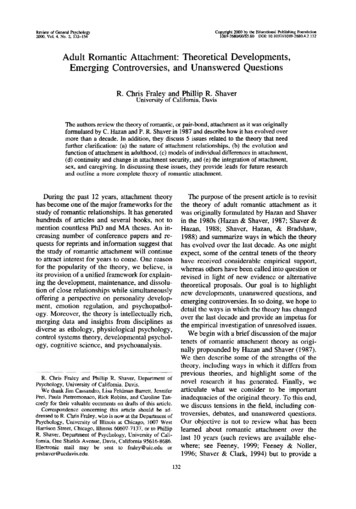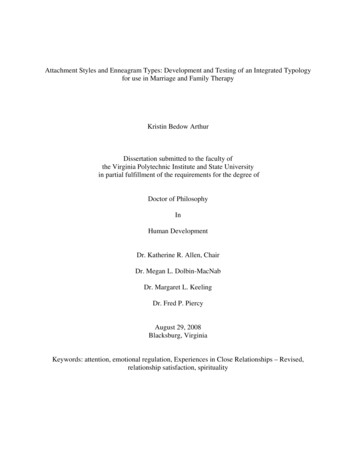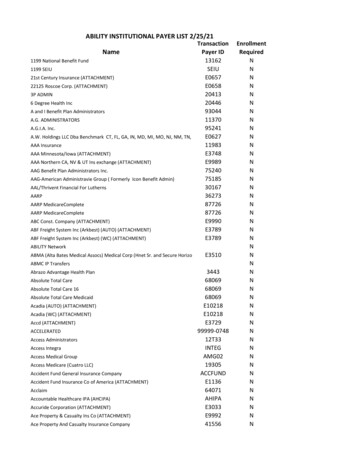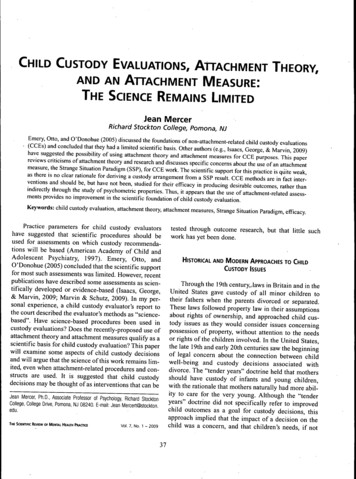
Transcription
CHILD CUSTODY EVALUATIONS, ATTACHMENT THEORY,AND AN ATTACHMENT MEASURE:THE SCIENCE REMAINS LIMITEDJean MercerRichard Stockton College, Pomona, NJEmery otto, and O'Donohue (2005) diseussed the foundations of non-attachment-related child custody evaluations (CCEs) and concluded that they had a limited scientific basis. Other authors (e.g., Isaacs, George, & Marvin 2009)have suggested the possibility of using attaehment theory and attachment measures for CCE purposes Thi¡ papereviews cnt.c.sms of attaehment theory and research and discusses specific concerns about the use of an attachmentmeasure, the Strange Situation Paradigm (SSP), for CCE work. The scientific support for this practice is qiiite weakas there is no clear rationale for deriving a custody arrangement from a SSP result. CCE methods are in fact interventions and should be, but have not been, studied for their efficacy in producing desirable outcomes, rather thanindirectly through the study of psychometric properties. Thus, it appears that the use of attachment-related assessments provides no improvement in the scientific foundation of child custody evaluation.Keywords: child custody evaluation, attachment theory, attachment measures. Strange Situation Paradigm, efficacy.Practice parameters for child custody evaluatorshave suggested that scientific procedures should beused for assessments on which custody recommendations will be based (American Academy of Child andtested through outcome research, but that little suchwork has yet been done,Adolescent Psychiatry, 1997). Emery, Otto, andU Donohue (2005) concluded that the scientific supportfor most such assessments was limited. However, recentHISTORICAL AND MODERN APPROACHES TO CHILDCUSTODY ISSUESpublications have described some assessments as seiennf.cally developed or ev.dence-based (Isaacs, George,& Marvm, 2009; Marvm & Schutz, 2009). In my personal experience, a child custody evaluator's report tothe court described the evaluator's methods as "sciencebased Have science-based procedures been used incustody evaluations? Does the recently-proposed use ofattachment theory and attachment measures qualify as ascientific basis for child custody evaluation? This paperwill examine some aspects of child custody decisionsand will argue that the science ofthis work remains limited, even when attachment-related procedures and constructs are used. It is suggested that child custodydecisions may be thought of as interventions that can beThrough the 19th century,.laws in Britain and in theUnited States gave custody of all minor children totheir fathers when the parents divorced or separatedThese laws followed property law in their assumptionsabout rights of ownership, and approached child custody issues as they would consider issues concerningpossession of property, without attention to the needsor rights of the children involved. In the United Statesthe late 19th and early 20th centuries saw the beginningof legal concern about the connection between childwell-being and custody decisions associated withdivorce. The "tender years" doctrine held that mothersshould have custody of infants and young childrenwith the rationale that mothers naturally had more abil-Jean Mercer, Ph.D., Associate Professor of Psychology, Richard StocktonCoiiege, Coiiege Drive, Pomona, NJ 08240. E-maii: Jean Mercert@stoci tonedu. " ' V í . "' "" doctrine did not specifically refer to improvedchild outcomes as a goal for custody decisions, thisapproach implied that the impact of a decision on thechild was a concem, and that children's needs, if notTHE saEmnc REVEW OF MENTAI HEALTH PRACHCEVol. 7, No. 1 200937
3gMERCERrights might be an aspect of the decision process(Gould & Martindale, 2007).Modern Child Custody PrinciplesIn the second half of the 20th century, children'sneeds were increasingly considered in child custodydecisions, although there was relatively little clarityabout what those needs might be.The best interests of the child. In the 1970s, a newcustody principle, that of "the best interests of thechild," was formulated (Goldstein, Freud, & Solnit,1973 1979) (Quotation marks are used with this termbecause it remains poorly defined and may in fact havedifferent meanings for different children.) This principie focuses on the needs of children as the most important factor in custody decisions. In the course of "bestinterests" decisions, courts are to seek the custody situation that will be least detrimental to the child's wellbeing and development, and to seek this arrangementthrough the least detrimental procedures available.Three major guidelines were offered and are stillemphasized: that custody decisions should considerchildren's need for continuity of relationships, that children's sense of time should be considered (especiallywith respect to the length of decision-making aboutvery young children), and that relationships cannot neeessarily be predicted over the long term, or supervisedeasily One "best interests" concept is rarely mentionedtoday that once custody is assigned, the custodial parent is the child's advocate and should be the one to makedecisions about visitation with the noncustodial parent(Solnit 1984) If this principle were applied, the importance of making the initial custody decision that is bestfor the child would clearly be maximized.Psychological parenting (attachment). The "best interests" concept considers a variety of factors that couldhelp determine a suitable custody arrangement for agiven child; one of these came to prominence in the1990s Issues related to the emotional attachment ofchild to parent (cf Bowlby, 1982) were introduced intofamily law under the term "psychological parenting"(Chenoweth 1992) This principle emphasized thechild's need for continuity of parenting, opposed abruptchanges of custody, and argued that biologically-unrelated caregivers might properly be considered suitablecandidates for custody, if their relationships with thechild justified this decision.The approximation rule. A recently-suggested principle for child custody decisions, the approximationrule (American Law Institute, 2002), holds that courtsshould establish custody and visitation schedules thatgive each parent a proportion of the child s time equivalent to the proportion of caregiving the parent carriedout in the past. This approach has been argued to provide a simplified procedure with advantages such asgender-neutrality, ,K idecent Applications of PrinciplestFor some years, custody decisions have commonlytaken into account some aspects of the phenomenoncalled "psychological parenting" in' some legal discussions, but referred to as "attachment" by mental healthprofessionals and developmental psychologists. Howeversuch decisions show many inconsistencies in the use ofattachment concepts.For example, in one New Jersey case(VC. v. M.J.B., 1999; see Mercer, 2006, for more exampies), it was suggested that three-year-olds are too youngto have real attachments, contrary to well-established evidence that children from age one to three years are espedaily vulnerable to the effects of custody changes TheAppeals Court in this case made its ¡decision by definingpsychological parenting as a matter of past history ratherthan a relationship indicated by child attachment behavior,In addition, the Appeals court specifically noted that theparenting role could not be defined by predictions offuture good or ill effects on the child; this line of reason- ing blurred the concept of "the best interests of the childby rejecting the importance of the developmental outcome. (For further discussion of the use of attachmentconcepts in custody decisions, see Mercer, 2006).As more is learned about complex environmentaleffects on development, the evolution of new principlesfor child custody decisions seems desirable from a mental health perspective. However, more complex views ofchildren's needs tend to trigger more complex evaluativeefforts, and thus lengthier, more costly court proceedings. Simple solutions, dealing with fewer child andfamily factors, are attractive to attorneys, judges, anddivorcing parents. The approximation rule, mentionedearlier in this paper, has some advantages over otherprinciples. While simple to understand, however, thisprinciple may be difficult to apply (Warshak, 2007). Inaddition, there is no clear reason to assume that approximation would yield results in children's best interests, agoal that may be vague but is still regularly appealed to.It is notable that the approximation rule has beenthought of as an accurate shortcut to consideration ofattachment issues (Kelly & Ward, 2002; Rohrbaugh,
CHILD CUSTODY AND AN AHACHMENT MEASURE39the amount of direct caretaking functions and the devel-Of the modes of CCE discussed earlier in this paperthose based on attachment concepts ha e the mosi(2005) has pomted out, however, this is far from a fore- acceptable empirical foundations. Thousands of s t u X '"P y ' « mem concepts and helped to estab' (1983)lish an evidence base connecting measures of attachn Z H th ?' . '" "* P able outcomes. It has been argued that somefather did little caregiving, toddlers showed securemeasures of attachment might be considered for use nattachments to their fathers as well as to their mothers.evaluating children's relationships with paints and th, ' -commending appropriate'custody and visitationmothers are likely to give rise to insecure schedules (Byrne, O'Connor, Marvin, & Whelan 2005)attachmen s in their children, even though the mothers Byrne et al. discussed the f¡ct that practice p a r l r sdo almost all the careg.ving (McKay, Shaver-Hast, for child custody evaluations (e.g., L e r i c a n AcademySharnoflf, Warren, & Wright, 2009). The argument that of Child and Adolescent Psychiatry, 1997) recommendhe approximation rule .s an indirect use of attachmentassessment of parent-child intera tions and Z ?"information is not well-supported by evidence.between these interactions and the child's developmentalneeds, and suggest that scientific procedures should be " * ' Scientific procedures might ' y '' ' ' 2005). Byrne et al. went on to commentMethodsthat "measures of parental personality or child behav' problems that have been validated in population' ' " ' l « «"Pl«« »"ay be subject to particularly " ! P« » bias when used in child custodyt, le reflected the conclusion that the methods were part evaluation . . . measures that have been shown to be relíof a flawed system based on "limited science". Emery able and valid outside a custody evaluation may not beb v t T d " " f H " ' 1 f P y' hological tests employed valid when used in a custody evaluation" (2005 p i 7) - " - g - * PO-ibiity that attachment measuresgence tests the Thematic Apperception Test, the might be helpful contributions to child custody deci '«" ' '' '- ed a measured conclusion no Bender-Gestalt, and other tests designed for clinicaling that "existing measures of attachment have n t yetassessment Forensic instruments, designed specifically received scrutiny in the context of divorce and custodyrTosí.' " " J attachments" (p. 359). As RiggsmTefs arTli I 7Snce t r th'e The'T' T'''" '''"" ' "" r " 'fEmery et al (2005) summarized the problematic seijf foundations of the clinical assessment instruS v rei y.t' / .' y evaluators. In addition, theyf.rnily rejected the forensic assessment instruments, noting hat these "measures assess ill-defined constructs,and they do so poorly, leaving no scientific justificationfor their use in child custody evaluations" (Emery et al.son, L.ienfeH and Vitacco, 2007).Not long before these two papers were written, psychologists and other interested professionals were beginning to discuss the possibility of applying attachmentheory and attachment measures to child custody évaluations (LLbs) and recommendations. Attachment-relatedTcatir H- ' 7' t' ""' « " " "tion in the pubhcations discussed so far, have now begun to be suggestedas highly appropriate frameworks for custody discussion.y-formagathered from the assessment is to the immediatestresses and conflicts occurring in the family" (2005 p121). Tippins and Wittman (2005) concurre commem .„g that although the developmental literature allowsreasonable conclusions about attachment patterns"there is virtually no empirical l i t e m t u r e Z aSows theclinician . . . to reliably suggest specific access p ansThis is because we do not o w how the eff t of such """ ' " " ' "" - f e enormously cornplex emotional life of the separating family" (p. 202)use of Attachment Measures inchild Custody EvaluationsThe comments of Byrne et al. presented attachmenttheory and measures as potential foundations for effective child custody decisions, but as clearly stated these
40MERCERauthors have concerns that existing research does notprovide the desired scientific basis for custody decisions Nevertheless, Schmidt et al., writing in 2007,stated that attachment-based protocols were appropriatefor assessment purposes in CCEs. In addition, thebrochure for a conference of the Association of Familyand Conciliation Courts (2009) contained the followingworkshop description: "This workshop will use a casestudy approach to demonstrate how incremental validityfor child custody evaluations can be increased with theinclusion of attachment measures. This venue breaksnew ground by giving legal professionals access to whatscience and informed psychologists think is 'right'regarding attachment" (p. 12). Isaacs, George, andMarvin (2009) the presenters at that workshop, published a case report of an evaluation that used attachmentmeasures How many other evaluators have argued thiswpv k unknownAs Byrne et al (2005) concluded, there is no outcome research directly testing the use of attachmentmeasures in child custody interventions, nor has empirical work answered other important questions aboutattachment measures and divorce. Marvin and Schutz(2009) have presented the argument that informationabout attachment measures is transportable from thestandardization groups to children under evaluation, butacknowledged that further evidence of direct connections is needed. The next section of this paper discussesattachment theory and evidence about attachment measures much of it involving the psychometric properties ofthe measures Given this information, to what extent canit be argued that attachment theory or research can begeneralized to provide a scientific foundation for custody recommendations based on attachment measures?Would the use of attachment measures mean that CCEcan employ better science than Emery, Otto, andO'Donohue concluded? What, specifically, would be theeffect of using the Strange Situation Paradigm (SSP), themost-researched method of attachment evaluation, thesubiect of great numbers of empirical studies since itwas first described by Ainsworth et al. in 1978?THEORETICAL AND EMPIRICAL WORK ON ATTACHMENTGENERAUZATION TO CHILD CUSTODY DECISIONSIt is of course, intuitively reasonable to turn toattachment theory when attempting to understand theimpact of family dissolution on children. Concernsabout separation and loss are at the heart of the divorceexperience, and constructs belonging to attachment the-ory are intended to deal with these issues. An examination of attachment theory and of evidence about measures.of attachment can help determme whether theseconstructs or measures are appropriate for use in CCbsThere are thousands of articles on attachment-relatedtopics in existence; those mentioned here are papers thatcritique attachment theory and measures in ways relevant to their use in custody decisions,The Concept of Attachment;. , . - Textbooks usually provide a metaphorical definitionof attachment as an emotional tie between parent andchild. Although appealingly simple, this metaphor is adeceptive one. Considering attachment as a "tie" impliesthat adult and child are identically connected with eachOther, whereas in fact the thoughts, emotions, and behavior of adults toward children are rather different thanthose ofchildren toward adults. Describing attachment asan "emotional" connection is an over-simplification, ascognitions and behavior are important parts of an attachment relationship. Even to emphasize the connection"between parent and child" is confusing, for much modern work examines attachment relationships as theyoccur between adults, as well as the influence of earlyattachment relationships on an adult's care of his or herown children.I suggest that attachment is best thought of as anattittide, or readiness to behave, which at its simplest discriminates between familiar and unfamiliar persons, andwhich motivates the individual's tendency to seek proximity to familiar persons when a threat is perceived, aswell as his or her response to others who are seekingproximity. The attachment attitude is initially apparentaround the end of the first year of life and is shown inyoung children's distress when separated from familiarcaregivers and their ability to use a familiar person as asecure base for exploration. Like other attitudes, attachment develops through maturation and experience andgradually becomes part of an internal working model ofsocial relationships rather than an isolated tendency. Theinternal working model provides guides for a variety ofrelationship functions including coupling and parenting,and includes emotions, thoughts and beliefs about relationships, and behaviors (including some that will not belearned until adolescence or adulthood). This definitionparallels to some extent the idea of attachment as anorganizational construct composed of a number otdeveloping systems relevant to attachment goals andneeds (Sroufe & Waters, 1977).
CHILD CUSTODY AND AN AHACHMENT MEASUREAttachment Theory41Attachment theory has been criticized for failure toBnefly stated, attachment theory descnbes andexplains certain aspects of personality development bas-theory hasingthisexplanat on nattitu'destypJalofciXen; teby newinfancy and toddlerhood. Children of this age are notablefor their strong reactions to the presence or absenc offamUiar earegivers, and attachment theory stresses theimportance of experiences of consistent ca'e, as opposedto experiences of separation or loss. Attachment'theoryposits that human beings develop internal working mod TT1w'ifye sr oñt Lr dt?Important evidence thatbe based to a considerable extent on e x p e n e n c e "relationships. This theory contains elements suggestingthe impact of family dissolution (or other losses onyoung Children, although it does not n e c e t n l y spe Iceffects on older children or adolescentsAttachment theory and CCE. The use of attachmenttheory as a foundation for CCE work has a cleÍr radonale. An important tenet of attachment theory is tha'earîvlRomaniani Íor poor outcomes.(Kaufman,(-8-, Lajble Panfile, &relationshipsshapepersonalitydeveCZtl l : s h thelp determine social relationships in later life, including friendships, marital relationships, and;contriste tloutcomes. SBowlby's ( 1982) formulation ofattachment theory, which appeared at oneTme to tclearly established, has altered over the yea n d c o Ítinues to evolve (Mercer, in press). Rutter 0995) pointedout revisions brought about'by discussion' andC ÏAs Waters and Cumniings (2000) noted,[mlaintjiining the coherence and empirical underpin-X?Xtrrts:data, and other areas of psychology, and subjectingthe theory to severe tests, tests which, if not passed,would require us to reject the theory, or at least tomake significant revisions, thereby influencing subsequent research (p. 164).„f f f f.mty Although a taxonomyff ' í "'' alegones or statuses was notan essen.ialE h h" """ " f .""T ' V' "'"' ' '"' " become part of the theory for all practical pur,h fof th.s use of categories goes back toIte development of the first attachment measure byAinsworth, et al. (1978). Ainsworth herself queried the'1children's response patterns better" dimensional system could. Other authors soonsuggested the advantages of a structural equation modeling approach instead of the taxonomy (Connell &Goldsmith, 1982), and later investigators concluded that
MERCERa continuum of attachment security gave a betterdescription than division into categories (Fraley &Spieker, 2003). However, these views remain largelyunintegrated into attachment research, and few effortshave been made to apply the dimensional approach toexistine work on attachment status as a predictor of attitudes or behavior.No clear update, but popularization. Although somework has been done to connect attachment theory withmore recent constructs such as mentalization (Fonagy etal 2002) no clear statement of a modernized theory isavkable to guide child custody evaluators (Schore'ssuggestions [Schore & Schore, 2008] not being adequatefor this purpose; see Mercer, in press).This is particularly the case for the theory as it is relevant to children, as much recent work has focused on therole of attachment constructs in adult personality.Unfortunately, in the absence of an updated form ofattachment theory, there has developed a popularized version that construes "almost any behavior or relationshipas evidence of an attachment problem . . . [ ; ] parentsbegin to frame all of their children's behavior as a resultof their early experiences and not as [a result] of aprocess of ongoing adaptation that remains modificable"(Nilsen 2003 p 303) Child custody evaluators andudges may b'e influenced in similar ways by popularforms of attachment theory. Ongoing criticisms of andgradual changes in attachment theory are essential to therefinement ofthis theory, like that of any other. However,the instability of some aspects of the theory at this point,the lack of integration of important evidence, and theinfluence of its popularized version tend to weaken itsusefiilness as a basis for legal decision-making.Attachment theory and divorce. As the presentlypreeminent theory of social and emotional relationshipsacross the lifespan, attachment theory is a natural framework for the consideration of the efl-ects of divorce onchildren The theory's attention to the impact of separation from a familiar person upon anxiety and grief is ofparticular importance. As a theory which has stimulatedmany thousands of empirical investigations, attachmenttheory could be expected to have stimulated collectionof much useful information about the impact of divorce.This is not the case, however. Most studies of the effectsof divorce on children do not assess attachment; the reasons for this are probably the costliness of the assessment of young children, and the absence of usefulmeasures for older children. A well-known paper byHetherington, Bridges, and Insabella (1998), which formulated important issues in the study of children's reactions to marital transitions, did not even mention theword"attachment". When the significance of divorce forattachment has been considered, divorce has general ybeen only one among a group of negative life events(see, for instance, Sroufe, 2005).iAttachment Measures., , rOf the various difficulties with the testing ofhypotheses derived from attachment theory, one oí themost serious is the challenge of measuremerit. Attachment theory posits an internal working model of socialrelationships that changes with age, and gives nse toattachment-related behaviors that also change with ageAny measure of the internal working model is indirectand based on relevant behaviors, which must be interpreted in the context of age differences as well as ofsocial history, culture, environmental factors and Possibly, individual differences (Laible, Panfile, & Makariev,2008). (However, researchers investigating genetic influenees have concluded that attachment shows little or noheritability [Roisman & Fraley, 2008]).Because there is no direct measure of attachment,and because developmental changes cause ongoing alter, ations in attachment behavior, it is difficult to determinethe validity of attachment measures. However, extensiveresearch has provided information about psychometricproperties of a number of attachment measures, somedesigned for children and some for adults. The presentpaper examines the use of the Strange Situation Paradigm(SSP), the oldest and best-researched of the rneasures forchildren, and therefore the measure most likely to beinvolved in claims of science-based assessment.The Strange Situation Paradigm. The best-knowriand most researched measure of children s emotionalattachment to familiar adults is the Strange SituationParadigm (SSP), a measure used by Isaacs, George, andMarvin (2009). This measure, first described in terms ofresearch evidence by Ainsworth and her co leagues(1978), is a standardized observation of a toddler s behavior during a series of separations from and reunionswith a familiar caregiver. The SSP was designed for usewith children from 9 to 18 months of age and is organized in time frames appropriate for that age group. Theprocedure is carried out in a laboratory setting and takesabout 20 minutes. Just over 100 children and their parents participated in the 1978 study.Interpretation of the child's behavior in the SSP musttake the child's age into account, as attachment behavioralters with developmental change. The evaluation methods designed by Ainsworth are not necessarily appropri-
CHILD CUSTODY AND AN AHACHMENT MEASUREate for children even a few months older than 18 months,as developmental change IS rapid at this period of life.Ainsworth s method uses information about childbehaviors (like proximity-seeking, contact-maintaining.avoidance and resistance) to categorize a child as showing one of three patterns of attachment. These patterns aresecure attachment (charactenstic of about 650/0 of toddlers), insecure-avoidant (20%), and insecure-resistant orambivalent attachment (I50/0) (Teti & Nakagawa, 1990).An additional category in use today, disorganized/disor-1Sif 43are required for certification on this test (Solomon &George, 1999). However, there is no mechanism forassuring that the test is used only by certified personsMain and Cassidy (1988) developed a classificationmethod for 6-year-olds, which examines reunion behavior following an hour-long separation, used because thebrief separations of the other protocols are not suffi!ciently stressful to bring about attachment behavior in achild this old. Children can be grouped as secure insecure-avoidant, insecure-controlling, or insecure-unclas-'' ''' '- '' « « »"«"t P ' dure was based on a« '"Ple of 83 middle-class children. Inter-rater reliabilitywas high, although less so for the controlling categoriescommon among young children whose families are Test-retest reliability was reported in the form of 62%divorcing (Solomon & George, 2001).stability of category (i.e., classifications remainedHigh inter-rater reliabilities are reported for the SSP unchanged) over a period of one month(Prior & Glaser, 2006). Some SSP assessments are alsoSchool-age children. Attempts have been made toreported to correlate with later functioning. In a longitu- assess attachments of school-age children to their pardinal study, the category disorganized/disoriented entsby means of methods like story stem interview techattachment in early childhood was the best single pre- niques and questionnaires, but little useful informationdictor of global pathology in the late teens (Sroufe, has resulted from these. One such study reported that noEgeland, Carlson &Collins, 2005), while avoidant consistent relationship was found between the interviewattachment showed a smaller but statistically significant and questionnaire measures (Kerns, Abraham Schlegelcorrelation. Similarly, disorganized attachment shownmilch, & Morgan, 2007). Separations such as those inon a shortened version of the SSP predicted question- the SSP are well-tolerated by school-age children andnaire responses about school adjustment and behavior reveal little about their attachment relationships As aproblems later, using a small group of children evaluated result of these problems, assessment methods for attachu J riSr( " ' "«' Riksen-Walraven, & Van ment in older children are still very limitedBakel, 2009) However, it should be noted that none ofStability of classification. Investigation of the stabilthe SSP-based categories ,s diagnostic of current pathol- ity of attachment categories is difficult, because chilogy, and that there is a diagnostic category. Reactive dren's attachment behavior changes rapidly and because'" '"" y ' ' ' '''' «"rement procedure can affecttion, 2000), which IS not assessed with the SSPthe response to a later procedure. Research in this areaMeasures for older age groups. The fact of rapid has concentrated on correlations between earlierdevelopment in all domains during the toddler period assigned attachment categories and later behaviors thatsuggests that an attachment rneasure suitable for a year- do not necessarily closely resemble the original behavold child will not be suitable for older toddlers, pre- iors. For example, avoidant or resistant toddlers haveschool, or kindergarten children. In response to thisbeen reported as likely to become overcontrolled kinderconcern, a Preschool Strange Situation (PSS) was devel- garteners (Easterbrooks & Goldberg 1990) Disoped by Cassidy, Marvin, and the MacArthur Working organized status in early life has been reported toGroup in the early 1990s. This procedure remains unpub- correlate with behavior problems later, as noted earlierhshed but was described by Pnor and Glaser (2006). The in this paper.PSS protocol is intended for 3- and 4-year-old childrenand uses either the SSP format or a modified method.Children assessed with the PSS are categorized asCRITICISMS OF THE STRANGE SITUA
CHILD CUSTODY EVALUATIONS, ATTACHMENT THEORY, AND AN ATTACHMENT MEASURE: THE SCIENCE REMAINS LIMITED Jean Mercer Richard Stockton College, Pomona, NJ Emery otto, and O'Donohue (2005) diseussed the foundations of non-attachment-related child custody evaluations (CCEs


